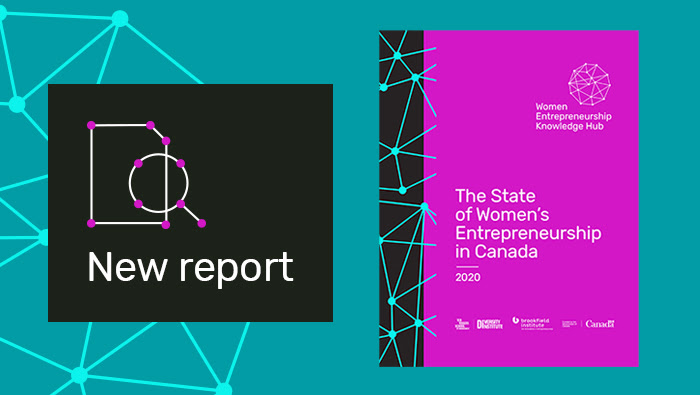Expanding the Definition of Entrepreneur to Empower More Women and Girls in Canada
Women entrepreneurs can fuel Canada’s COVID-19 recovery and help build back a better country. However, significant structural barriers highlighted in new research from the Women Entrepreneurship Knowledge Hub (WEKH) make it difficult for women entrepreneurs to access finance, networks, and business opportunities. Mounting evidence shows that these barriers have been amplified by the COVID-19 pandemic—particularly for Black people, Indigenous people, and other persons of colour.
“The State of Women’s Entrepreneurship in Canada” synthesizes government, academic, and expert research to better understand the challenges facing women entrepreneurs in Canada, as well as the opportunities to grow women’s entrepreneurship. WEKH Director Wendy Cukier launched the report during the “She Leads; Canada Prospers: The Importance of Women’s Entrepreneurship for Economic Recovery” webinar hosted by the Ontario Chamber of Commerce and Michelle Eaton, Vice President, Public Affairs at the OCC.

Rachel Bendayan, Parliamentary Secretary to the Minister of Small Business, Export Promotion and International Trade opened the discussion highlighting the programs available to women entrepreneurs, and emphasized the critical importance of women’s inclusion in Canada’s recovery from the COVID-19 pandemic. “We know that for the economy to fully rebound we need women to be at the table…Women are an integral part of the relaunch of our economy. That diversity and talent that we bring to the table is incredibly important,” MP Bendayan stressed.
Many women can contribute to the rebuilding of the country through entrepreneurship. However, “How you define ‘entrepreneur’ has a profound impact on women,” Dr. Cukier noted. While 15.6 percent of SMEs in Canada are majority owned by women (equalling 114,000 women) 37.6 percent of self-employed Canadians, or 1,079,000 individuals, in 2019 were women. Dr. Cukier noted that it is critically important to take a broad view of what an entrepreneur is that includes self-employed women when we think about how to grow entrepreneurship in Canada.
There are also cultural understandings of entrepreneurship that can prevent diverse women and girls from seeing entrepreneurship as a viable option. Many associate the word “entrepreneur” with white men like Mark Zuckerberg, Bill Gates and Elon Musk and fail to recognize the contributions of diverse women entrepreneurs in Canada. The emphasis on science, technology, math and engineering (STEM) in discussions about entrepreneurship can also alienate women and girls with different talents and obstruct opportunities for growth and innovation in other sectors.
“We need to really challenge some of the assumptions of what an entrepreneur is, what an entrepreneur does, and what an entrepreneur looks like,” Dr. Cukier argued.
These assumptions and definitions have clear implications on women entrepreneurs in Canada. Dr. Cukier noted, for instance, that men are four times more likely than women to receive venture capital funding or angel investment. Due to an absence of female-friendly pedagogy and gaps in financial literacy, women are also less likely to seek financing than men.
Being a Woman Entrepreneur in Canada
Diverse women in business face additional challenges in building and sustaining their firms due to systemic discrimination and gender bias weaved through our institutions, culture, and everyday lives. “It’s not in your head. The evidence is very clear. Systemic discrimination with respect to women, systemic racism—all of those things are real. We need, therefore, a systemic solution to tackling those problems,” Dr. Cukier stressed.

Katie Zeppieri, Founder & CEO of the GIRL TALK Speakers Bureau, hosted an engaging discussion about what being a woman entrepreneur in Canada is like with Nadine Spencer, President & CEO, BrandEQ Group; Nicole Verkindt, Founder, OMX; and Tabatha Bull, President and CEO, Canadian Council for Aboriginal Business.
Panelists underlined the kinds of racism and bias that make it unduly difficult for diverse women entrepreneurs to succeed in business. “When you see me as a person walking into a room, you see Black first. Unlike other business and professional communities, our climb is difficult at every stage because of the colour of our skin. Years and years and decades of discrimination in the workplace has been an ongoing hindrance to progress, equity and efficiency in our society for Black female entrepreneurs,” Spencer explained.
For Indigenous women entrepreneurs, significant barriers in accessing finance remain a pressing concern. Bull noted how provisions in the Indian Act, for example, make it extremely difficult for Indigenous women entrepreneurs to access loans. Entrepreneurs who live on reserve lands are often unable to receive loans because their property cannot be used as collateral. “We see less than 30 percent of Indigenous businesses in general accessing loans through traditional financial institutions.”
Verkindt noted that COVID-19 has drastically changed consumer behaviour and driven unprecedented numbers of shoppers online. This presents a challenge for Indigenous entrepreneurs outside of urban centers who cannot facilitate in-person sales due to COVID and are facing a lack of high-quality and reliable basic infrastructure like high-speed internet access.
Bull stressed that cultural differences and norms such as these must be considered when developing programs designed to empower diverse women entrepreneurs. “We need to really be looking specifically at the unique barriers from a diversity perspective,” Bull explained.
Spencer echoed this point and underlined the importance of including diverse voices in crafting a post-COVID future for Canadians.
“We need to make sure that our concerns and our voices are heard, and not just tolerated. Until leaders truly start taking what we have to say seriously, we won’t see lasting change. On a more long-term basis, we need to see greater diversity and representation in government” she said.
Looking Ahead
There are no simple solutions to the complex problems facing diverse women entrepreneurs. The report argues that a systems approach is necessary, like the Critical Ecological Model, to move toward an inclusive innovation ecosystem. Such a model would address the structural barriers women entrepreneurs face in Canada at the societal, organizational, and individual levels.
“The State of Women’s Entrepreneurship in Canada” also highlights the progress that is being made in the women entrepreneurship ecosystem. For instance, export activity among majority women-owned SMEs has doubled from 5.9% in 2007 to 10.8% in 2017. Dr. Cukier’s presentation highlighted opportunities facing women entrepreneurs in Quebec, immigrant women entrepreneurs, Indigenous women entrepreneurs, social entrepreneurs, and women entrepreneurs in tech, agriculture, and the arts.
“The results of this report indicate that there are important signs of progress and a number of areas of growth and opportunities to advance women-led enterprises in Canada. It also serves as a guide to many on where they can focus their programming and supports,” Eaton explained.
Learn More

Read “The State of Women’s Entrepreneurship in Canada” to learn more about our findings, and share your thoughts online using #WEKH.
Were you unable to attend the launch? Watch it on-demand.
Be among the first to receive all our latest research by signing-up for our newsletter.
